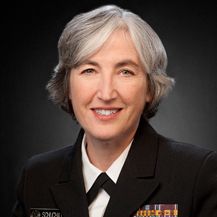Article
Synthetic Opioids Fuel Growing US Overdose Deaths
Author(s):
A CDC analysis found that overall drug overdose death rates increased by 21.5%, but those involving synthetic opioids more than doubled.

Anne Schuchat, M.D.
A comprehensive evaluation of the 2016 US drug overdose data indicates that the opioid epidemic has spread geographically and increased across demographic groups. The analysis, from researchers at the Centers for Disease Control and Prevention (CDC), was published in today’s issue of Morbidity and Mortality Weekly Report.
In 2016, drug overdoses killed 63,632 Americans and nearly 66% of those deaths involved a prescription or illicit opioid. The CDC’s analysis indicates that recent increases in drug overdose deaths have been driven by growth in deaths involving synthetic opioids other than methadone, including illicitly manufactured fentanyl (IMF).
The study, based on 2015-2016 data from 31 states and Washington, D.C., found that the largest increase in opioid overdose deaths was in males between the ages of 25-44. Overall drug overdose death rates increased by 21.5%, but those involving synthetic opioids (other than methadone) more than doubled.
Between 2015-2016, rates of death from overdoses involving synthetic opioids increased in 21 states and in 10 states those rates doubled. New Hampshire, West Virginia, and Massachusetts had the highest death rates from synthetic opioids.
“No area of the United States is exempt from this epidemic—we all know a friend, family member, or loved one devastated by opioids,” said CDC Principal Deputy Director Anne Schuchat, M.D. “All branches of the federal government are working together to reduce the availability of illicit drugs, prevent deaths from overdoses, treat people with substance-use disorders, and prevent people from starting using drugs in the first place.”
Earlier this month, President Trump announced a plan that included a call for a decrease in the use of opioid medication. The President’s plan also called for research into and development of non-addictive pain management options as alternatives to opioid prescriptions.
The CDC’s guidelines for prescribing opioids recommend nonpharmacologic therapy and nonopioid pharmacologic therapy (including acetaminophen, NSAIDs, and selected antidepressants and anticonvulsants) for chronic pain.
“Clinicians should consider opioid therapy only if expected benefits for both pain and function are anticipated to outweigh risks to the patient,” state the guidelines.
Studies continue to explore alternatives to opioid medication, including cannabis. Researchers in Pennsylvania are planning a to evaluate the benefits of medical marijuana as an alternative pain management strategy.
Ari C. Greis, DO, a clinical assistant professor in the Department of Physical Medicine and Rehabilitation at the Rothman Institute of Thomas Jefferson University, who will lead the study, said the evidence for cannabis as a pain management treatment is mounting.
“Recent studies are showing that opioids don’t work well for chronic pain, and the available literature on cannabis for pain is very promising,” Greis said. “Having access to cannabis seems to reduce opioid use and related overdose mortality rates.”
For post-operative patients, a recent study examined a promising anesthetic (HTX-011) that resulted in significant reductions in pain intensity and opioid medication use in the 72 hours after the surgery.
There is a "desperate need for effective non-opioid alternatives,” said Eugene R. Viscusi, MD, Professor of Anesthesiology and Chief of Pain Medicine at the Sidney Kimmel Medical College of Thomas Jefferson University in Philadelphia. “The phase 3 results with HTX-011 suggest it may be a promising foundation in non-opioid multimodal pain management in a wide range of surgical procedures.”
While research into and development of alternatives to opioids continue, the CDC’s report emphasizes the need for a cooperative strategy to expand treatment for opioid dependency, reduce the illicit opioid supply, and improve opioid prescription methods to prevent addiction, among other steps.
“Effective, synchronized programs to prevent drug overdoses will require coordination of law enforcement, first responders, mental health/substance-abuse providers, public health agencies, and community partners,” said the CDC report’s lead author, Puja Seth, PhD.





